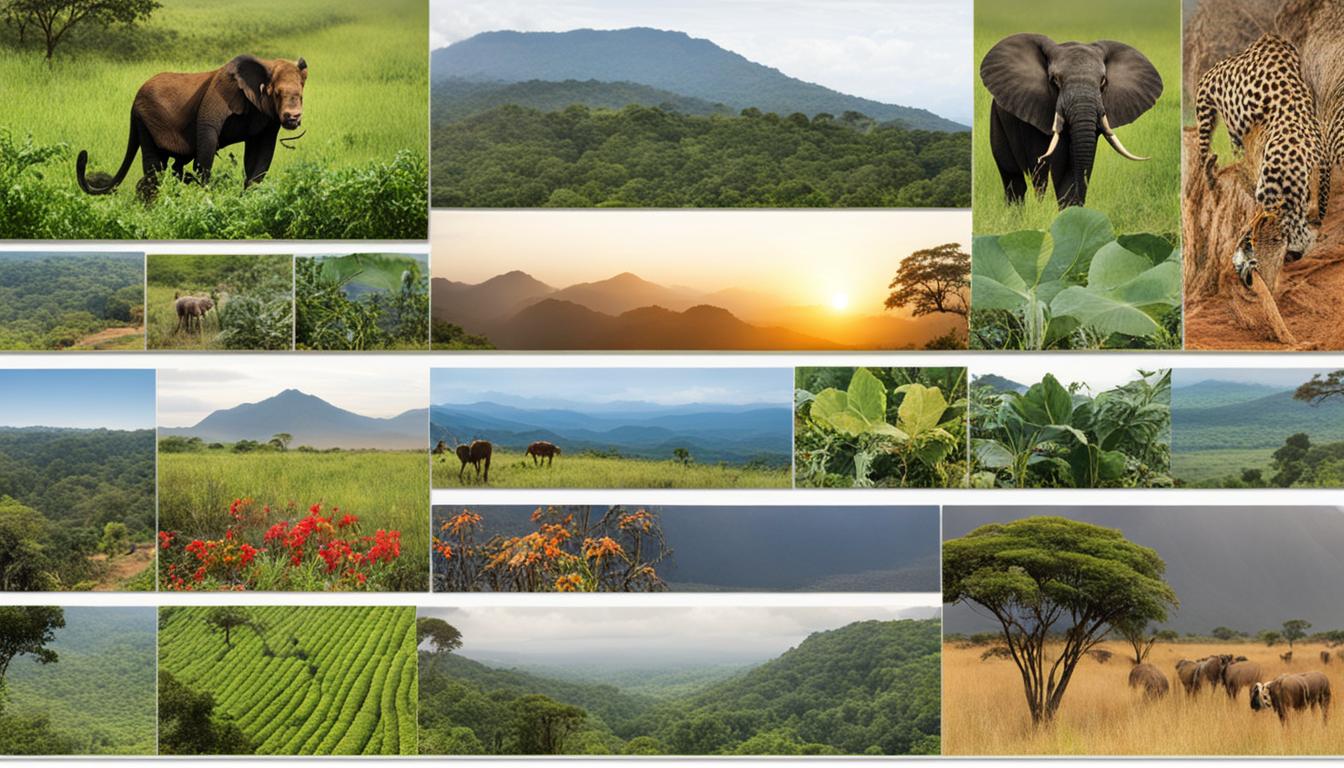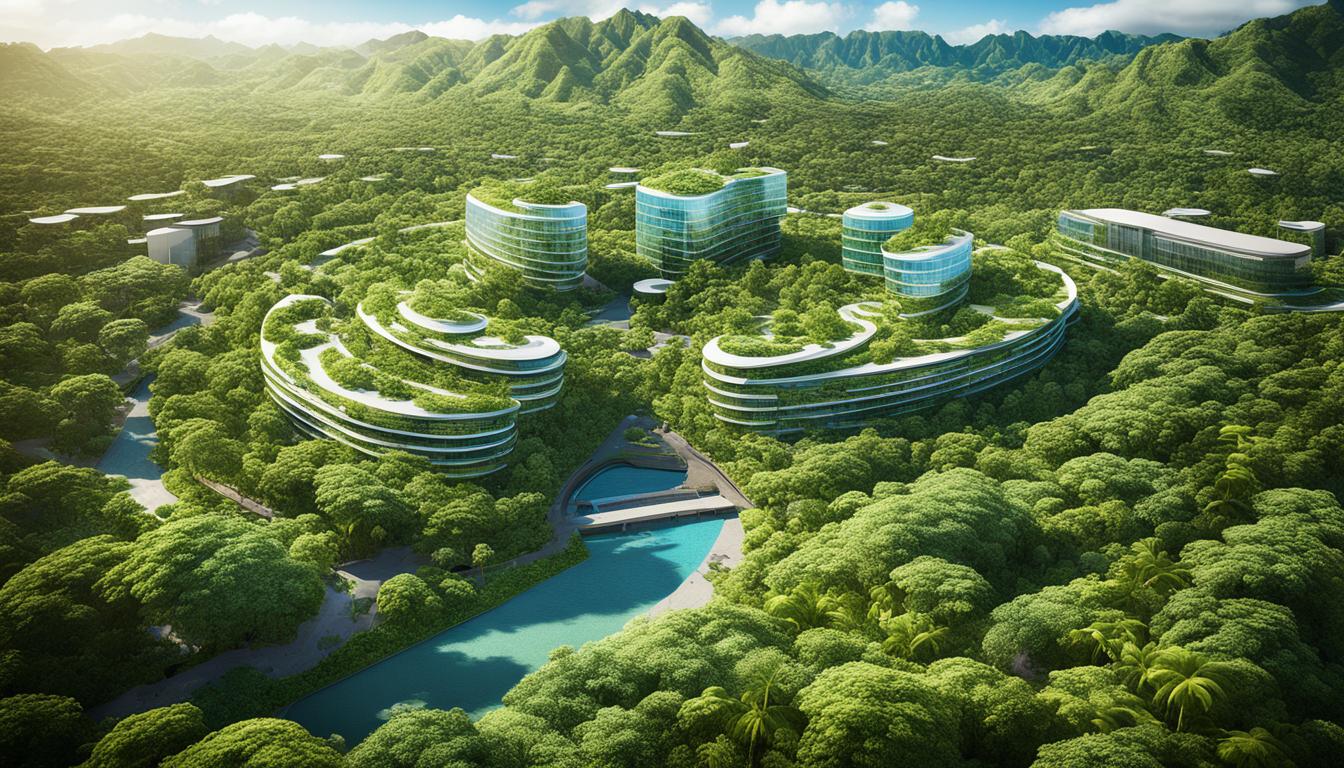Lithuania Biodiversity: Animal and Plant Species and What Is Under Threat
Lithuania is known for its rich biodiversity, boasting a diverse range of animal and plant species. The country’s ecosystems encompass an array of natural and semi-natural habitats, including forests, wetlands, and meadows. With forests covering 33% of the country’s territory and wetlands accounting for 7.9%, Lithuania is home to a remarkable variety of flora and fauna.
However, the preservation of this precious biodiversity is under threat. Rapid land degradation due to drainage, peat extraction, and the expansion of agricultural land has led to the loss of 70% of wetlands between 1960 and 1980. Additionally, the construction of dams and anthropogenic eutrophication have negatively impacted Lithuania’s aquatic ecosystems, including rivers and lakes. The degradation of these vital ecosystems has resulted in habitat loss and a decline in wildlife species.
Key Takeaways:
- Lithuania is home to a rich diversity of animal and plant species, with forests covering 33% of its territory and wetlands accounting for 7.9%.
- Rapid land degradation, including drainage, peat extraction, and agricultural expansion, has led to the loss of 70% of wetlands.
- The construction of dams and anthropogenic eutrophication have negatively impacted Lithuania’s aquatic ecosystems.
- Habitat loss and a decline in wildlife species are some of the consequences of ecosystem degradation in Lithuania.
- Efforts are being made to conserve Lithuania’s biodiversity through protected areas, restoration projects, and species conservation plans.
Importance of Forests in Lithuania
Forests play a crucial role in Lithuania’s biodiversity. They cover 33% of the country’s territory and provide a habitat for a wide variety of plant and animal species. The forest cover in Lithuania has been increasing in recent years, with a 2% growth since 2001. This is a result of the country’s commitment to forest conservation and sustainable management.
The significance of Lithuanian forests goes beyond their ecological value. Forests also contribute to the economy, providing timber and other forest products. They are an important source of income for local communities and contribute to the country’s overall well-being.
To protect the invaluable forests, Lithuania has designated a significant portion of its forested areas as protected areas. In fact, 54% of the Natura 2000 network, which aims to preserve Europe’s most valuable and threatened species and habitats, is composed of forests in Lithuania.
“Forests are the lungs of our planet, and their preservation is essential for the well-being of current and future generations.” – Environmental Minister of Lithuania
Forest Cover in Lithuania
| Year | Forest Cover (%) | Change from Previous Year (%) |
|---|---|---|
| 2001 | 31 | N/A |
| 2005 | 32 | +1 |
| 2010 | 33 | +1 |
| 2015 | 34 | +1 |
| 2020 | 33 | -1 |
The table above illustrates the changes in forest cover in Lithuania over the past two decades. While there has been a slight decrease in forest cover since 2015, the overall trend shows a positive increase in the country’s forested area, reflecting the efforts in forest conservation and management.
In addition to their ecological and economic importance, Lithuanian forests also provide various ecosystem services. They regulate the climate, protect against soil erosion, and filter water. Forests also offer recreational opportunities, attracting tourists and nature enthusiasts.
Protecting Lithuanian forests is not only crucial for the country’s biodiversity but also contributes to global efforts in mitigating climate change. Forest conservation and sustainable management are essential to ensure the well-being of both nature and society.
Challenges Faced by Wetland Ecosystems
Wetland ecosystems in Lithuania have been significantly impacted by drainage and peat extraction, leading to the loss of 70% of wetlands between 1960 and 1980. This loss has resulted in profound changes in the plant communities of wetlands, with moss and grass communities being replaced by trees and shrubs. The decline in the water table has also led to drier conditions in fens. These alterations have had a detrimental effect on the biodiversity of wetland ecosystems, causing the loss of habitats for various plant and animal species.
Efforts are underway to restore and protect the remaining wetland areas in Lithuania, as these ecosystems play a crucial role in maintaining a healthy environment. Wetlands provide numerous ecosystem services, such as water purification, flood mitigation, and habitat for unique species. Additionally, they are important carbon sinks, helping to mitigate climate change. Wetland conservation in Lithuania is essential for preserving these invaluable ecosystems and protecting the diverse range of species that depend on them.

| Wetland Conservation Challenges | Consequences |
|---|---|
| Drainage and peat extraction | Loss of wetland habitats and biodiversity |
| Changes in plant communities | Replacement of moss and grass communities by trees and shrubs |
| Decline in water table | Drier conditions in fens and altered hydrology |
Status of Aquatic Ecosystems in Lithuania
Lithuania boasts an impressive network of 29,000 rivers, spanning a total length of 64,000 km. However, the construction of dams has had a devastating impact on the region’s aquatic ecosystems, leading to the disappearance of approximately 70% of the spawning sites for potential catadromous fish species. This loss not only disrupts the natural life cycle of these fish but also poses a significant threat to the overall biodiversity of Lithuanian rivers and lakes.
Furthermore, aquatic ecosystems in Lithuania continue to face the challenges of anthropogenic eutrophication. Human activities, such as excessive fertilizer use and the discharge of pollutants, have resulted in increased nutrient levels in the water, leading to harmful algal blooms and oxygen depletion. These detrimental effects further disrupt the delicate balance of these ecosystems and contribute to the decline of aquatic species.
It is essential to prioritize the conservation and restoration of Lithuanian rivers and lakes to ensure the long-term health of these vital ecosystems. Efforts must be made to mitigate the impact of dams on fish migration patterns and restore spawning sites. Additionally, measures should be implemented to reduce nutrient pollution and promote sustainable land management practices to address the issue of eutrophication.

Impacts on Agricultural Land and Invasive Species
Agricultural land plays a significant role in Lithuania, covering 54% of the country’s territory. This land is mainly used for arable farming and meadows, supporting the nation’s agricultural sector and providing essential resources. However, the conservation of this land faces challenges, particularly in relation to invasive species.
Approximately 400,000 hectares of agricultural land in Lithuania are currently not farmed and have become ecological niches for weeds and invasive plant species. These invasive species pose a growing threat to Lithuania’s biodiversity, as they outcompete native flora and disrupt the natural balance of ecosystems.
Additionally, agricultural practices have contributed to the deterioration of meadows. The expansion of crop areas and the decline in grazing and mowing practices have resulted in the loss of meadow habitats and the decline of plant and animal species that depend on them.
It is crucial to address these impacts on agricultural land and invasive species to preserve Lithuania’s biodiversity and ensure the sustainability of its agricultural sector. Conservation efforts, including the management of invasive species and the promotion of sustainable farming practices, are key to mitigating these threats.

| Impacts on Agricultural Land and Invasive Species | Effects |
|---|---|
| Invasive Plant Species | Outcompete native flora, disrupt ecosystems |
| Unfarmed Agricultural Land | Ecological niches for weeds and invasive species |
| Expansion of Crop Areas | Loss of meadow habitats |
| Decline in Grazing and Mowing Practices | Loss of meadow biodiversity |
Conservation Efforts and Protection Measures
Lithuania has taken several proactive measures to preserve its rich biodiversity and safeguard its natural resources. The country has established a comprehensive network of protected areas, encompassing both terrestrial and marine sites, which constitute a significant portion of Lithuania’s territory. These protected areas serve as sanctuaries for a multitude of plant and animal species, ensuring their continued survival and promoting a healthy and balanced ecosystem.
In addition to protected areas, Lithuania has implemented specific conservation plans and management strategies for these designated territories. These plans focus on the sustainable utilization of natural resources, such as forests and wetlands, and aim to strike a harmonious balance between human activities and biodiversity preservation. By carefully managing these areas, Lithuania seeks to safeguard valuable habitats and sensitive ecosystems.
One noteworthy success in Lithuania’s conservation efforts is the preservation of fish spawning grounds. Through well-designed legislation and active monitoring, the country has effectively protected crucial breeding habitats, ensuring the survival and abundance of various fish species. This includes the successful conservation of the iconic salmon, a species that relies on pristine aquatic environments to complete its life cycle.
Furthermore, Lithuania has embraced environmentally friendly practices in agriculture, promoting organic farming methods and the adoption of sustainable agricultural techniques. By reducing the use of chemical fertilizers, pesticides, and other harmful substances, Lithuania hopes to mitigate the negative impacts of agricultural activities on biodiversity and create a healthier environment for both wildlife and humans.
To enhance the overall conservation efforts, Lithuania has also prioritized the development of green infrastructure. Green infrastructure refers to the planned network of natural and semi-natural areas, such as parks, green spaces, and urban forests, that support biodiversity and provide various ecosystem services. These green spaces not only serve as vital habitats for wildlife but also contribute to the overall well-being of the local communities and enhance the quality of life in urban areas.
By focusing on protected areas, conservation plans, legislation, organic farming, and green infrastructure, Lithuania is demonstrating its commitment to preserving its unique biodiversity. Through these combined efforts, the country aims to ensure the long-term sustainability of its ecosystems, foster a harmonious relationship between humans and nature, and leave a legacy of diverse and thriving flora and fauna for future generations.

Threatened Species in Lithuania
Lithuania’s Red Data Book provides a concerning insight into the state of endangered species in the country. According to the book, 18.9% of all plant species, 1.87% of fungi species, and 31% of lichen species known to Lithuania are endangered. Furthermore, the book lists 8% of fish species, 18 out of 70 mammal species, 5 amphibian and reptile species, and 80 bird species as threatened. The main threat to these species is the loss, degradation, or fragmentation of their habitats.

Endangered Species in Lithuania
| Type of Species | Percentage Endangered |
|---|---|
| Plant | 18.9% |
| Fungi | 1.87% |
| Lichens | 31% |
| Fish | 8% |
| Mammals | 18 out of 70 species |
| Amphibians and Reptiles | 5 species |
| Birds | 80 species |
This alarming situation calls for urgent efforts to conserve and protect Lithuania’s biodiversity. By implementing effective conservation measures and addressing the issues causing habitat loss, we can help ensure the survival of these endangered species for future generations.
Threats to the Baltic Sea
The Baltic Sea, known for its stunning beauty, is unfortunately facing significant threats that are endangering its delicate ecosystem. Among the most pressing concerns are Baltic Sea pollution, eutrophication, and the urgent need for conservation efforts.
One-fifth of the Baltic Sea area is now characterized as dead zones, a shocking statistic that highlights the extent of pollution in this precious body of water. Numerous factors contribute to this distressing situation, with agricultural pollution being a primary culprit. The leakage of nitrogen and phosphorus from agricultural activities contaminates the sea, leading to eutrophication, a process that disrupts the delicate balance of marine life by causing excessive algae growth.
In addition to agricultural pollution, irresponsible fishing practices, sea transport, and port development projects have also exerted a negative impact on the environment of the Baltic Sea. These human activities further contribute to the pollution and degradation of this unique marine ecosystem.
Efforts are underway to tackle these pressing issues and mitigate the damage caused by pollution and eutrophication. The reduction of eutrophication levels is a top priority in order to protect the resources of the Baltic Sea and preserve its natural beauty for future generations.

Conservation Initiatives and Successes
Lithuania has made significant strides in biodiversity conservation, implementing various initiatives and achieving notable successes. These efforts contribute to the preservation of the country’s unique flora and fauna for future generations.
Terrestrial Protected Areas
Lithuania has taken significant steps in expanding its terrestrial protected areas network. The country has successfully increased coverage to 15.64% of its territory, safeguarding important habitats and ecosystem diversity. Particularly, the conservation efforts in forest environments have reached significant milestones, ensuring the protection of valuable ecosystems and their associated species.
Wetland Habitats and Special Protected Areas
Another area of focus in Lithuania’s conservation initiatives is the designation and management of wetland habitats. These areas are carefully monitored and protected to sustain the rich biodiversity they support. Additionally, Lithuania has established special protected areas in various regions, safeguarding critical habitats and biodiversity hotspots.
Conservation of Endangered Species
Lithuania is committed to conserving endangered species through targeted measures and actions. The country has implemented comprehensive conservation plans, reinforcing legislation to protect vulnerable species. Notably, Lithuania has also pioneered ex situ conservation by establishing botanical reserves, ensuring the safeguarding of plant species that face significant threats in their natural habitats.
Promotion of Organic Farming and Green Infrastructure
Lithuania recognizes the importance of sustainable agricultural practices in biodiversity conservation. To that end, the country has witnessed an increase in the adoption of organic farming methods, reducing the reliance on harmful pesticides and promoting a more harmonious coexistence between agriculture and nature. Additionally, Lithuania has placed emphasis on the development of green infrastructure, creating interconnected networks of green spaces that provide essential habitats for a diverse range of species.
This comprehensive approach to biodiversity conservation in Lithuania has yielded positive results and showcases the country’s commitment to protecting and preserving its natural heritage.

Conclusion
Lithuania’s biodiversity is under threat due to habitat loss, invasive species, and pollution. However, the country has taken proactive steps to combat these challenges and preserve its natural heritage. Through the designation of protected areas, restoration efforts, and conservation initiatives, Lithuania is working towards the preservation of its unique flora and fauna.
The conservation of endangered species and the restoration of ecosystems have been at the forefront of Lithuania’s efforts. The country recognizes the importance of its biodiversity in providing essential ecosystem services. By protecting these valuable resources, Lithuania not only safeguards its natural heritage but also ensures the provision of clean air, water, and other vital services that support human well-being.
Elevating awareness is another vital aspect of Lithuania’s conservation strategy. Engaging stakeholders and securing financing are ongoing efforts aimed at promoting sustainable practices and garnering support for biodiversity preservation. Through a collective commitment to continued conservation, Lithuania aims to pass on a thriving natural environment to future generations, ensuring the long-term sustainability of its ecosystem services.
FAQ
What is the current state of Lithuania’s biodiversity?
Lithuania’s ecosystems, including forests, wetlands, and meadows, have been greatly impacted by human activities. Forests cover 33% of the country’s territory, while wetlands cover 7.9%. However, wetlands have experienced significant loss due to drainage and peat extraction. Meadows have also been affected by land reclamation and agricultural expansion. The degradation of ecosystems has resulted in habitat loss and a decline in wildlife species.
How important are forests in Lithuania’s biodiversity?
Forests play a crucial role in Lithuania’s biodiversity. They cover 33% of the country’s territory and provide habitat for a wide variety of plant and animal species. Efforts have been made to increase forest cover and designate protected areas within commercial forest areas to preserve valuable habitats and rare species.
What are the challenges faced by wetland ecosystems in Lithuania?
Wetland ecosystems in Lithuania have been greatly impacted by drainage and peat extraction. Between 1960 and 1980, 70% of wetlands were lost, resulting in changes to plant communities and a decline in biodiversity. Efforts are being made to restore and protect remaining wetland areas.
What is the status of aquatic ecosystems in Lithuania?
Lithuania is home to numerous rivers and lakes, but the construction of dams has led to the disappearance of spawning sites for fish species. Anthropogenic eutrophication also negatively impacts river and lake ecosystems. These factors have had a detrimental effect on the biodiversity of aquatic ecosystems.
How does agricultural land impact Lithuania’s biodiversity?
Agricultural land comprises 54% of Lithuania’s territory, with a significant portion not being farmed and providing habitat for invasive species. The expansion of crop areas and changes in farming practices have led to the deterioration of meadows. Invasive species pose a growing threat to Lithuania’s biodiversity.
What conservation efforts and protection measures are in place in Lithuania?
Lithuania has designated protected areas, implemented species conservation plans, and established legislation to protect fish spawning grounds. The country has also promoted organic farming and green infrastructure to contribute to biodiversity conservation.
What are some of the threatened species in Lithuania?
The Lithuanian Red Data Book lists endangered plant, fungi, lichen, fish, mammal, amphibian, reptile, and bird species. The loss, degradation, or fragmentation of habitats is the main threat to these species.
What are the threats to the Baltic Sea?
The Baltic Sea is heavily polluted, primarily due to agricultural pollution, irresponsible fishing practices, and sea transport. Eutrophication caused by nitrogen and phosphorus leakage is a major issue. Efforts are being made to reduce pollution and conserve the resources of the Baltic Sea.
What conservation initiatives and successes have occurred in Lithuania?
Lithuania has increased its protected areas network, implemented species conservation plans, and achieved milestones in forest conservation. The country has also seen an increase in organic farming and the development of green infrastructure.
Why is preserving Lithuania’s biodiversity important?
Preserving Lithuania’s biodiversity is crucial for maintaining ecological balance and the provision of ecosystem services. Efforts to conserve biodiversity aim to protect valuable habitats, rare species, and maintain the ecological services that benefit both nature and people.








